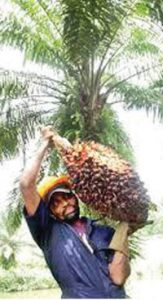Palm oil producers await positive Govt response


Sri Lanka could reduce the import bill of USD 60 million spent on palm and coconut oil imports and become a palm oil exporting country if the current restrictions on oil palm plantations are lifted, said officials of the Palm Oil Producers Association.
Among the vegetable oils consumed as food in the world, palm oil is the leading type of oil.
Palm oil is one of the world’s most sustainable and economically productive crops. Only 5% of the world’s cultivated land is used for oil palm cultivation. Palm oil supplies 38% of the world’s vegetable oil supply from this 5% land area.
The secret to producing more oil with less land is that palm oil yields 10 times more per hectare than other oil crops.
“The global demand is increasing and the economic scope is expanding and Sri Lanka too should cash in on this situation by moving towards growing palm oil and then moving to exports.”
However, due one-sided unfair lobbying by pressure groups the Government which had encouraged the growing of palm oil cultivations suddenly reversed its decision and banned the replanting of palm oil.
“This decision was one-sided and we are lobbying the government to lift this ban and there is a positive response.”
The Association says that annually over 180,000-220,000 units of vegetable oil are imported.
“Apart from this, about 190,000 metric tons of coconut oil is also imported in anticipation of price control and consumption needs.”
“While over USD 60 million is being spent on imports every year, problems have also arisen regarding the health safety of the imported coconut oil as revealed in the last COPE committee.”
“If this ban can be lifted, Palm oil can be grown again. This will help in totally reducing the import bill of edible oils, which can save a lot of money for the national economy.”
“The Association plans to use abandoned rubber estates to grow oil palm after the lifting of the ban.”
Oil palm in Sri Lanka is cultivated without clearing forests in any way. The area of 11,132 hectares currently cultivated is the specialty of rubber cultivated land that does not receive expired income.
Barren lands
The oil palm grows well in areas with strong sunlight and high rainfall in the tropics and produces high yields in areas with temperatures of 24-32C and rainfall of 2500 mm.
According to the Plantation Management Monitoring Division (PMDD) and existing laws, 20,000 hectares were identified as oil palm cultivation lands. That is, only up to 3% of the land used for agricultural activities in the country.
There are many untapped benefits in the palm oil industry. The first of these is Sri Lanka’s potential to become a palm oil exporting country in the future which will automatically save the importing of food grade palm oil and coconut oil which annually account to around US$ 60 million.
The second is the economic benefits of the palm industry as it provides higher income compared to other crops. “That benefit reaches the smallholder who grows palm trees and the workers.”
Due to this high income, countries like Indonesia and Malaysia relentlessly opened up tropical rain forests and expanded the cultivated land, and due to this, environmental problems as well as socio-economic problems arose.
But they have found the answer to that problem by moving quickly to a sustainable production process. The most unique fact is that even though oil palm has been cultivated in those countries for over 100 years, there are no reports of a lack of rainfall or a dry environmental condition in those countries.
In Malaysia, 6,000,000 hectares of oil palm are cultivated, of which 40% or more are cultivated by small-scale growers.
In this way, the cultivation of palm oil has brought about a great revival in the rural economies of countries such as Malaysia and Indonesia.
It has helped millions of people rise out of poverty and into a prosperous future.
By reducing the problems, those countries are currently achieving the three-year development goals, and have become the world’s leading suppliers of vegetable oil. The main source of foreign exchange earnings in these countries is the palm oil industry.
India which was importing palm oil with an annual import bill of over USD 8 billion have now started growing palm oil.
India from importer to exporter
During 2019-2020, 350,000 hectares of oil palm were cultivated in India, and the yield of palm oil was 270,000 metric tons.
The goal of President Modi’s government is to expand that amount to one million hectares by 2025-2026. The expected yield of palm oil is 1.12 million tons. By 2030, cultivation is expected to increase to 16.7 million hectares, with an expected yield of 6.6 million tons.
In the implementation of this expansion, it can be recognised that the Indian government is dealing with the prospects of sustainable development according to a national policy. It can be recognized that this Indian model is more suitable for Sri Lanka.
In 2016, permission was granted to increase the land area of 11,132 hectares to 20,000 hectares, considering the national interest and utility, under the approval and supervision of the Coconut Research Institute as well as the Coconut Development Board.
The basic expectation was to reduce the amount of vegetable oil imported annually, and to establish palm oil as a new industry and to introduce non-revenue rubber land for cultivation in the districts of Kegalle, Kalutara, Ratnapura, Galle, and Matara.
In 2021, the Government imposed restrictions to stop the expansion of oil palm and to gradually reduce the cultivated land, while the seeds for new plantations are being brought and the nursery is being set up.
The annual production of coconut oil in this country varies according to the fruit yield and it is estimated to be 35,000 metric tons. Thirty percent of which is exported. The annual production of palm oil in this country is 27,000 metric tons.